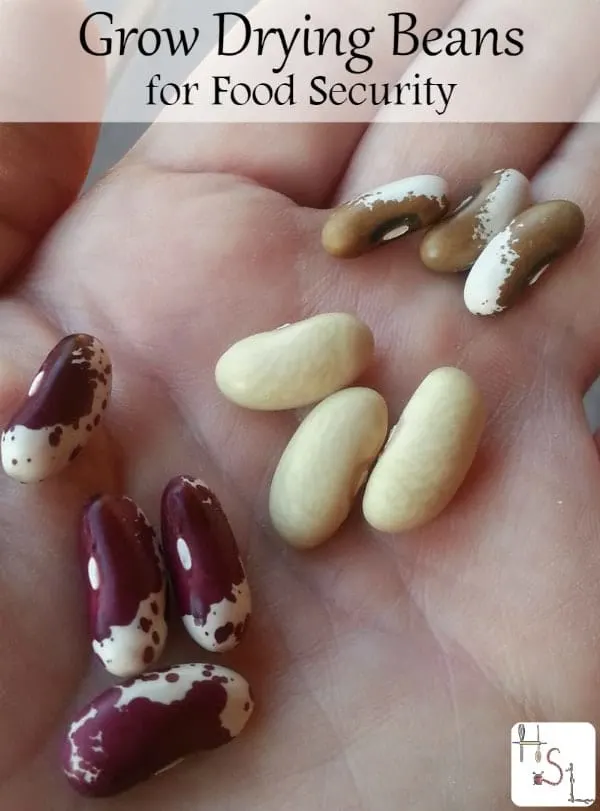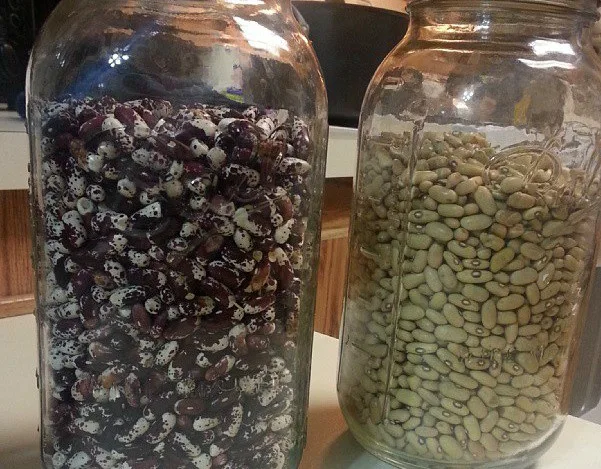When looking to increase home food security, many of us plant gardens. We fill those gardens with tomatoes, greens, peppers, zucchini, and more. Wonderful vegetables all of them fresh and preserved, however; many of those vegetables lack ease in preservation and calorie density. We need nutrient dense calories to do the hard work of homesteading and living fiercely D.I.Y. lifestyles. This is where the humble and often unappreciated drying bean becomes important. After all, drying beans are easy to grow, the final food is also next year’s seed, mother nature and time do all the preservation work, and they fill the pantry with healthy, calorie dense food. Grow drying beans for food security in your garden and reap the tasty, healthy rewards later.

Growing Drying Beans
Drying beans are mostly grown just like green or wax beans. There are bush and pole types in drying beans too. Grow whichever you prefer knowing that pole beans will need some kind of trellis and bush will not. Personally, I grow bush types because I’m lazy and dislike dealing with the trellising. Choose a type that will mature in your growing season. I’m in Zone 4B, for example, and choose beans with a 90-day or less growing season requirement (some varieties I love include: Jacob’s Cattle, Arikara Yellow, Painted Pony).
Plant after the last frost date. Plant beans 1 1/2 inches apart in rows 18 inches apart – 6 to a square for the square foot gardeners. It helps to soften the beans by soaking them in water prior to planting. I forget to do that more often than I remember and my plants always do fine, honestly. Beans tend to do well even in poor soil because they have some ability to be nitrogen-fixing naturally.
Let the beans grow, flower, and produce beans, watering as you do normally.

Harvesting Drying Beans
Let those beans get dry and crispy right on the plant. When the pods are dry and don’t give at all to the pressure of squeezing fingers, pull the pods from the plant. Wait too long and the pods split, spilling drying beans to the ground. Harvest too soon and the beans will likely mold in storage.
The beans will need to be removed from the pod. There are a number of ways to do this:
- Place in a pillow case in a clothes dryer and tumble
- Pulling apart by hand – time consuming but doable especially for smaller harvests
- Walk on the beans and then winnow the chaff with the wind or a fan
Threshing and winnowing are the most time-consuming parts of drying beans but the reward is great.
Spread the beans out onto baking sheets and let air dry for 2 weeks. This extra bit of time assures all moisture is gone before storage. Store in airtight jars.
Save some of those beans in the seed box for next year’s garden. Beans rarely cross meaning that you can save some of the beans each year to plant in next year’s garden.
Cooking with Dried Beans
Cooking with homegrown dried beans is the same as cooking with store bought dried beans. They need to be soaked first and then cooked to be used in recipes like:
Dried beans store perfectly well in glass jars with no extra canning or freezing needed. However, dried beans can indeed be canned if you’d like to have some cooked and on hand for quick meals and snacks.

As the gardening season approaches, be sure to add some drying bean seeds to your seed purchase and increase your food security this year.
Jerry Nelson
Wednesday 8th of March 2017
I love growing dried beans, the variety is amazing, although I must confess there is not a huge difference in taste between them that I can discern. I love the colors and markings, my favorites are Jacobs Cattle, Hidatsa Shield, Good Mother Stallard, and, of course, red kidney and white navy. I store them in quart jars in my pantry and have lots to share. I also can several pints, usually from the previous year's crop as I am putting up the new crop. Canned beans, tomatoes, and canned beef makes for a chili in just a few minutes. For threshing, I save a few chicken feed bags, fill them with the dried pods, and walk on them to crush the pods, then winnow them in the Wyoming wind. You may not rescue every one, but you will get most of them.
Sandy j
Thursday 31st of August 2023
@Mary, If you are worried about them freeze them first make sure they're dry before you vaccuum seal them. I put them in a freezer for a couple weeks even when I buy them from the store to make sure there's no bugs in them.
Mary
Wednesday 30th of August 2017
My concerns are that I have harvested dried beans n absolutely love them. Last year I had loads of barlotti dried beans but six month months on I found weevils in v glass jars! What can I do do avoid this happening to my dried beans again this year please.
Heather
Sunday 18th of September 2016
Hi! Can you use just any dried bean from the grocery store to do this?
Homespun Seasonal Living
Sunday 18th of September 2016
Not always. Give it a try by trying to sprout some of the beans first. If they sprout, they'll likely grow in the garden, if they don't - they won't. Sometimes beans sold for food in the grocery are treated with heat to make sure they're completely dry and that can damage their ability to sprout and grow.
Diane Logan
Wednesday 8th of June 2016
Hi! How many plants did it require to yield those quart jars of dried beans?
Homespun Seasonal Living
Wednesday 8th of June 2016
Those are actually 1/2 gallon jars and they were 30 foot rows of each bean.